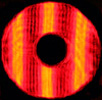November 19,
2011: How
to pack a mirror properly (my way)
This
is how I usually pack mirrors up to and including 24" in diameter.
A 26" would probably be OK, too. Larger mirrors use similar
methods, but are packed in wood crates and shipped via freight.
The keys are - use a strong box, tape it securely, and make sure there is at least 2" of foam on all sides of
the mirror. It's nice to have 3" on the sides if possible.
For small mirrors, 1.5" might be enough. Sometimes
other high-quality,
flexible foam is used (the white crumbly stuff is weak, annoying junk),
and occasionally cardboard is stacked on top to help fill
up a box if there is empty space at the top.
Some
shippers might promote the "squishy box" theory - that is, cushion the
blow. However, I'd say that I promote the "foam brick" theory.
The blow may not be cushioned, but a truck could run over the box
and the mirror would probably survive. The harder foam also
resists penetrations a bit better than softer stuff. Admit it -
you've received a package with a nasty-looking hole poked in it at some
point, so think of that when packing your mirror.
In this example, a 24" x 1.5" mirror is packed into a 30" x 30" x 6"
(inner dimension) heavy-duty Uline box. The box was cut down in
height from its original 30".
Uncoated mirrors are easier to clean and less delicate than
coated mirrors, because the coating is more easily scratched. In either case, the mirror should be cleaned before
shipping so that dust or dirt do not harm the surface during the
vibration and shocks/drops of shipping.
First,
the mirror is cleaned. Then a few layers of acid-free paper is
taped over the clean mirror's surface (below). The paper should
not be able to move around. Acid-free paper will not react with
the mirror's surface if the mirror is not unpacked or shipped promptly.
If you don't have it, try to find soft tissue paper free of dyes,
lotions, or other chemicals, and try to minimize the time that the
paper is agains the mirror's surface.
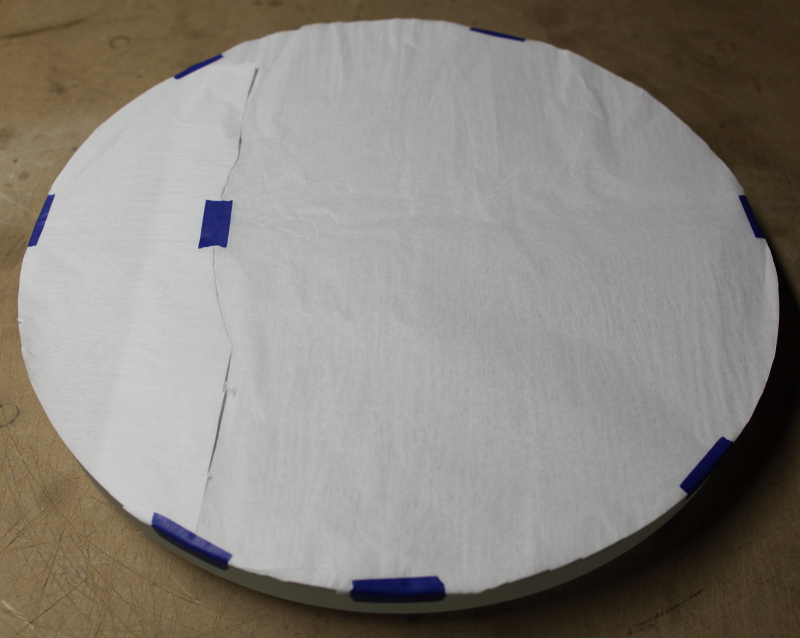
Next,
a cardboard disk is cut and taped securely over the paper, preventing
anything from getting in between, holding the paper stationary,
and protecting the surface. A coater once told me that regular
masking tape was leaving a residue and was making his job harder, so I
immediately switched to the blue painters-type tape.
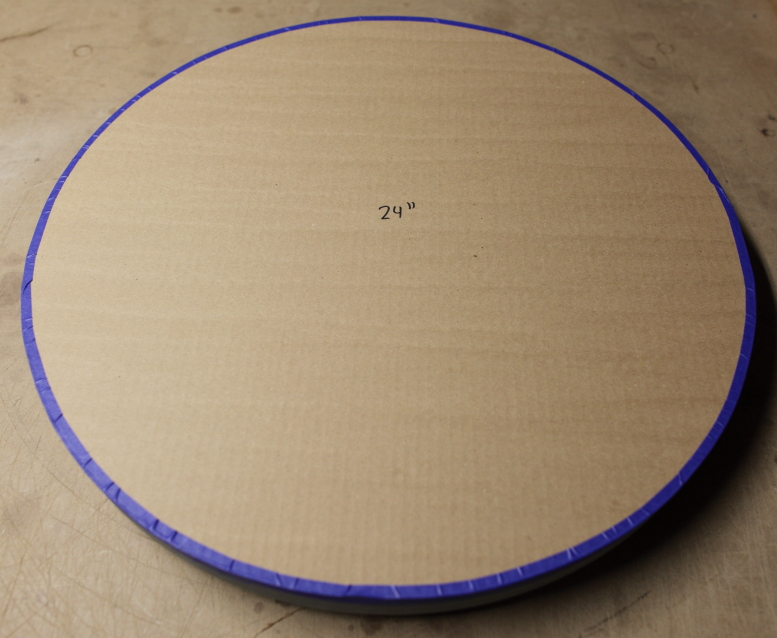
The
mirror is placed in a box with foam cut to fit snugly around it
(below). I use a small, cheap bandsaw to cut out the circular
hole for the mirror. A knife will do a messier job, but will
work. A hot-wire cutter would be nice.
The mirror should
not be able to move around, and cardboard can be wedged in around the
edges of the mirror or box, or on top of the mirror to take up extra
wiggle-room. In this case, a few pieces of loose cardboard were
placed on top to keep the mirror from moving vertically.
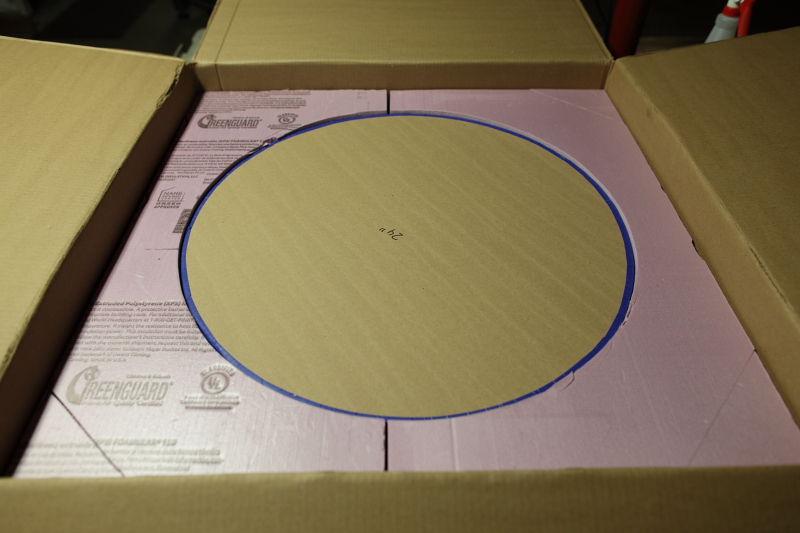
Finally, the box is filled the rest of the way with foam.
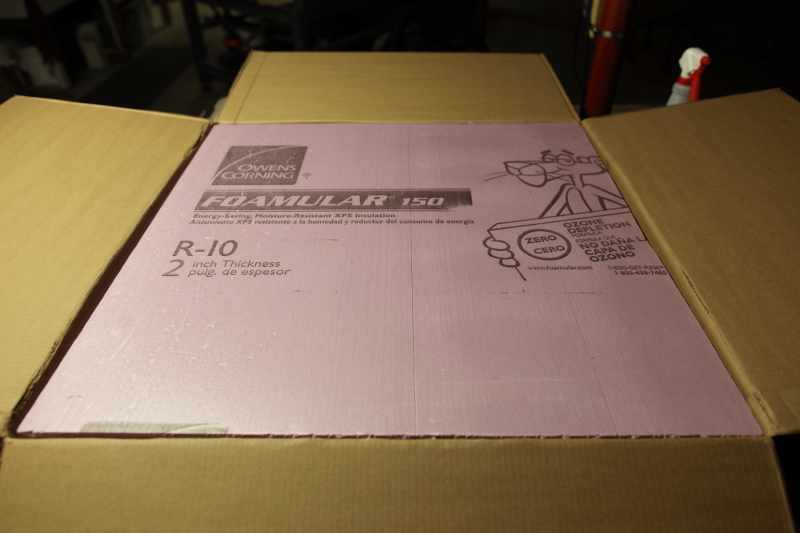
The flaps are securely taped where they meet, the edges of the
box/flaps are taped, and I also run tape around the box to further
strengthen it. Any corners that appear weak are also taped.
Don't forget to check the bottom of the box, where flaps are
often not taped. Use wide, good quality packing tape. It's
worth it.
The goal is to make the box as rigid as possible - any
flexure of the box is bad, and will allow the contents to move or
shift. It will also stress the tape, corners, and other weak
points of box.
In short, it is my goal to ship a foam "brick" that can only be opened with a knife.
You
can also see why I charge for a new packing box. The foam and box
are not free, and it takes me some time to get everything to fit
properly. It is also incentive for the shipper to pack it
properly in the first place!
Shipping
insurance is an option,
but with this type of packing your mirror should withstand rough
handling and make it to its destination OK unless the truck goes up in
flames or the plane crashes. That is quite unlikely, and in terms
of statistics, the mirror is far more likely to be lost than damaged
like that.
To reduce the chance of loss, I print my shipping labels ahead of
time and drop the boxes off at a staffed location (usually
FedEx/Kinkos) when I am in town. They don't add additional
charges like the UPS Store. Having a label helps reduce address
errors and time spent waiting for a clerk to do it. I would use
UPS if there were a more convenient drop-off location near me that
didn't up-charge.
So far the only problem I have experienced was
with a small mirror shipped by the USPS, as I was instructed to do by
the client. The post office managed to get the box wet, damaging
the coating because it was not immediately dried out.
Here are some more thoughts on packing:
I have to buy 30"x30"x30" boxes in a quantity of 10 each, shipped
freight from Uline. I buy many sizes at a time, and they all show
up in flattened form on a pallet. I have forks for my tractor so
I can load and unload crates, pallets, etc. Most new boxes are
too large to ship UPS or FedEx. Then I have to custom-cut the 30"
boxes down to the right height, typically ending up about 7" tall
including the thickness of the top and bottom of the box.
I ship up through 24" and 25" mirrors in cardboard boxes. For
these large sizes, the boxes are triple wall and are taped with high
strength professional tape, such as 3" Kraft paper tape with strands of
reinforcing fibers imbedded in it, and 3" wide clear packing
tape. For lighter, smaller mirrors, double wall works fine.
I take great care in taping up the boxes inside and out to strengthen
them, and I tape the corner of the box where the seam is. Taping
properly is very important to the structural integrity of the box.
I like to have a minimum of 2" of foam on all sides of the mirror, and
3" if possible. For example, I ship a 22" mirror in a 28"x28"
box. I use 1.5" and 2" thick hard foam (typically blue or pink,
sold in 4'x8' sheets at home improvement stores) cut as accurately as
possible so that the mirror does not have room to bounce around in the
box. The less the mirror can move, the less it will beat up the
foam internally. I have also experimented with hot-gluing the
layers of foam together, and reinforcing the sides of the box with thin
plywood to help make the box more durable. Still, shipping large
mirrors in a box will lead to the box and packing eventually getting a
bit beat up.
When cutting the foam, cut a place where whomever is packing/unpacking
the mirror can get their hand under the mirror to lift it out of the
foam. I typically do this closest to the corner of the box,
cutting a ~4"x1" piece out of the layer that goes around the mirror,
and making a depression in the layer underneath so one can get their
fingers under it. This will encourage nicer handling of the
mirror and the box and foam, and this is good all around.
Shipping freight is a pain and can be expensive if you don't regularly
work with a freight company like I do, and don't have a machine capable
of picking things off trucks. Avoid it when you can.
It has been my experience that UPS and FedEx see wooden crates as a
CHALLENGE, not something that is protecting something inside!
It's like they try to find ways to break them. They also hate
handling them because they are hard to handle and because of splinters.
So, if sending a wooden box via these shippers, be nice wrap it in a
layer of cardboard or put the wooden box in a cardboard box. This
will help it to be treated more kindly by everyone, in my experience.
If you can find sheets of heavy cardboard (it is sold for packing
purposes), you can MAKE YOUR OWN BOX. Use a roller (dull pizza
cutter) to "score" a line along which the cardboard can be
folded. Buy a roll or two of high-quality, 3" wide tape and make
TWO boxes, one nested inside the other. Then put foam inside of
that. That should get your mirror there safely, and it will be
re-usable.
Lastly, insurance purchased through UPS and FedEx is expensive.
Also, you may have problems getting a claim simply because the item is
glass. So, you may be paying this money for nothing. I
typically don't insure mirrors of this size - I pack them
properly. (My business insurance covers some of this
now.) If packed properly, the primary risk of shipping is
LOSS or THEFT. So, sign up for a UPS or FedEx account and print
the label yourself. You can get better rates this way, too.
Put tape over it to protect the label. Also, put another copy of
the label inside the box, just in case. Make quite sure the
address you are shipping to is correct, and that someone will be there
to sign for it when it is received. Checking the "signature
required" option is a good idea. Likewise, ask that you be
informed when the mirror ships back to you, and get a tracking
number. If you sign up for a free service like "UPS My Choice",
you will get an email when something is shipped to you, and you have
options to have it held if you are not going to be home, etc. The
best way is simply to be there personally to receive the mirror when it
comes back. All of this greatly reduces the chance of loss.
After you ship or receive your well-packed mirror, please check back for future installements of "In
the Shop".
Mike
Lockwood
Lockwood Custom Optics


